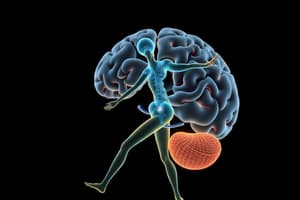Podcast
Questions and Answers
What occurs during isometric contraction?
What occurs during isometric contraction?
- Muscle tension decreases while length remains unchanged.
- Muscle length remains unchanged and decreases tension.
- Muscle tension increases without changing its length. (correct)
- Muscle length decreases while exerting force.
Which type of receptor organ primarily senses changes in muscle tension?
Which type of receptor organ primarily senses changes in muscle tension?
- Neural Pathways
- Muscle Spindles
- Joint Receptors
- Golgi Tendon Organs (correct)
What is a key characteristic of the stretch reflex?
What is a key characteristic of the stretch reflex?
- It involves coordination of opposing muscle groups.
- It occurs in response to a relaxing muscle.
- It is an automatic response to sudden stretching. (correct)
- It is a voluntary response to painful stimuli.
What does motor equivalence allow in the context of central sensorimotor programs?
What does motor equivalence allow in the context of central sensorimotor programs?
Which statement about functional brain imaging of sensorimotor learning is accurate?
Which statement about functional brain imaging of sensorimotor learning is accurate?
What is the primary function of spinal circuits in sensorimotor function?
What is the primary function of spinal circuits in sensorimotor function?
What role does the posterior parietal cortex play in sensorimotor function?
What role does the posterior parietal cortex play in sensorimotor function?
Which type of pathways is responsible for controlling fine movements such as those of the hands and fingers?
Which type of pathways is responsible for controlling fine movements such as those of the hands and fingers?
What is a critical function of the cerebellum in sensorimotor processing?
What is a critical function of the cerebellum in sensorimotor processing?
What is the primary responsibility of the primary motor cortex?
What is the primary responsibility of the primary motor cortex?
What does contralateral neglect refer to in sensorimotor disorders?
What does contralateral neglect refer to in sensorimotor disorders?
Which type of muscle fibers are best suited for endurance activities?
Which type of muscle fibers are best suited for endurance activities?
How do mirror neurons contribute to sensorimotor function?
How do mirror neurons contribute to sensorimotor function?
Flashcards are hidden until you start studying
Study Notes
Sensorimotor Spinal Circuits
- Spinal circuits control fundamental movements without input from the brain, enabling reflexes and basic actions.
Central Sensorimotor Programs and Learning
- Initial motor tasks require conscious effort, but become automated with practice, resulting in smooth and efficient movements.
Sensorimotor Association Cortex
- Integrates sensory and motor information to guide behavior and attention.
Posterior Parietal Cortex
- Combines spatial information.
Dorsolateral Prefrontal Cortex
- Involved in planning and decision-making.
Disorders of Sensorimotor Function
- Apraxia is difficulty carrying out voluntary movements independent of motor deficits.
- Contralateral neglect involves failure to respond to stimuli on the side opposite a brain lesion.
Secondary Motor Cortex
- Receives input from the association cortex and transmits signals to the primary motor cortex, playing a pivotal role in movement planning and coordination.
Mirror Neurons
- Fire both when someone performs an action and when they observe the same action taking place, contributing to the understanding of others' movements.
Primary Motor Cortex
- Located in the precentral gyrus of the frontal lobe.
- Directs voluntary movements.
Motor Homunculus
- A map depicting the motor control of different body parts within the cortex.
Effects of Primary Motor Cortex Lesions
- Widespread damage may result in less significant impairment than expected, suggesting redundant motor control pathways.
Cerebellum
- Coordinates and refines movements based on sensory feedback.
- Involved in timing, motor learning, and cognitive and emotional processing.
Basal Ganglia
- Regulates motor output and is crucial for habit learning and cognitive functions due to connections with the prefrontal cortex.
Descending Motor Pathways
- Dorsolateral pathways control fine movements (e.g., hand and finger movements).
- Ventromedial pathways manage posture and whole-body movements.
Types of Muscle Fibers
- Fast muscle fibers contract quickly and generate high force but fatigue rapidly.
- Slow muscle fibers sustain contractions for longer durations, suitable for endurance activities.
Types of Muscle Contraction
- Isometric contraction: Muscle tension increases without shortening (e.g., holding a weight).
- Dynamic contraction: Muscle shortens while exerting force (e.g., lifting an object).
Receptor Organs of Tendons and Muscles
- Muscle spindles detect changes in muscle length; they trigger reflexes to prevent overstretching.
- Golgi Tendon Organs sense muscle tension; They prevent excessive contraction to protect muscles.
Muscle Reflexes
- Stretch reflex: Automatic response to sudden stretching (e.g., knee-jerk reflex).
- Withdrawal reflex: Rapid response to painful stimuli, involving immediate muscle contraction.
Reciprocal Innervation
- Coordination mechanism for smooth movements where opposing muscles work in tandem; One muscle contracts while the opposing muscle relaxes.
Hierarchy of Central Sensorimotor Programs
- The sensorimotor system operates hierarchically, with higher levels coordinating complex actions and lower levels functioning autonomously.
Characteristics of Central Sensorimotor Programs
- Motor equivalence: Programs can adapt to different movements to achieve the same goal.
- Sensory feedback: Programs can develop without practice and improve with experience.
Functional Brain Imaging of Sensorimotor Learning
- PET scans show increased activity in sensorimotor areas during learning, with a decrease in activity as tasks become practiced.
Studying That Suits You
Use AI to generate personalized quizzes and flashcards to suit your learning preferences.




